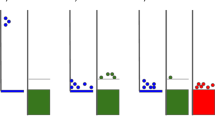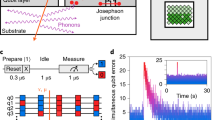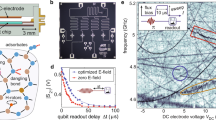Abstract
Technologies that rely on quantum bits (qubits) require long coherence times and high-fidelity operations1. Superconducting qubits are one of the leading platforms for achieving these objectives2,3. However, the coherence of superconducting qubits is affected by the breaking of Cooper pairs of electrons4,5,6. The experimentally observed density of the broken Cooper pairs, referred to as quasiparticles, is orders of magnitude higher than the value predicted at equilibrium by the Bardeen–Cooper–Schrieffer theory of superconductivity7,8,9. Previous work10,11,12 has shown that infrared photons considerably increase the quasiparticle density, yet even in the best-isolated systems, it remains much higher10 than expected, suggesting that another generation mechanism exists13. Here we provide evidence that ionizing radiation from environmental radioactive materials and cosmic rays contributes to this observed difference. The effect of ionizing radiation leads to an elevated quasiparticle density, which we predict would ultimately limit the coherence times of superconducting qubits of the type measured here to milliseconds. We further demonstrate that radiation shielding reduces the flux of ionizing radiation and thereby increases the energy-relaxation time. Albeit a small effect for today’s qubits, reducing or mitigating the impact of ionizing radiation will be critical for realizing fault-tolerant superconducting quantum computers.
This is a preview of subscription content, access via your institution
Access options
Access Nature and 54 other Nature Portfolio journals
Get Nature+, our best-value online-access subscription
$29.99 / 30 days
cancel any time
Subscribe to this journal
Receive 51 print issues and online access
$199.00 per year
only $3.90 per issue
Buy this article
- Purchase on Springer Link
- Instant access to full article PDF
Prices may be subject to local taxes which are calculated during checkout




Similar content being viewed by others
Data availability
The data that support the findings of this study are available from the corresponding author upon reasonable request and with the permission of the US Government sponsors who funded the work.
Code availability
The code used for the analyses is available from the corresponding author upon reasonable request and with the permission of the US Government sponsors who funded the work.
Change history
12 September 2020
A Correction to this paper has been published: https://doi.org/10.1038/s41586-020-2754-2
References
DiVincenzo, D. The physical implementation of quantum computation. Fortschr. Phys. 48, 771–783 (2000).
Arute, F. et al. Quantum supremacy using a programmable superconducting processor. Nature 574, 505–510 (2019).
Kandala, A. et al. Error mitigation extends the computational reach of a noisy quantum processor. Nature 567, 491–495 (2019).
Lutchyn, R., Glazman, L. & Larkin, A. Kinetics of the superconducting charge qubit in the presence of a quasiparticle. Phys. Rev. B 74, 064515 (2006).
Martinis, J. M., Ansmann, M. & Aumentado, J. Energy decay in superconducting Josephson-junction qubits from nonequilibrium quasiparticle excitations. Phys. Rev. Lett. 103, 097002 (2009).
Jin, X. et al. Thermal and residual excited-state population in a 3D transmon qubit. Phys. Rev. Lett. 114, 240501 (2015).
Serniak, K. et al. Hot nonequilibrium quasiparticles in transmon qubits. Phys. Rev. Lett. 121, 157701 (2018).
Aumentado, J., Keller, M. W., Martinis, J. M. & Devoret, M. H. Nonequilibrium quasiparticles and 2e periodicity in single-Cooper-pair transistors. Phys. Rev. Lett. 92, 066802 (2004).
Taupin, M., Khaymovich, I., Meschke, M., Mel’nikov, A. & Pekola, J. Tunable quasiparticle trapping in Meissner and vortex states of mesoscopic superconductors. Nat. Commun. 7, 10977 (2016).
Serniak, K. et al. Direct dispersive monitoring of charge parity in offset-charge-sensitive transmons. Phys. Rev. Appl. 12, 014052 (2019).
Córcoles, A. D. et al. Protecting superconducting qubits from radiation. Appl. Phys. Lett. 99, 181906 (2011).
Barends, R. et al. Minimizing quasiparticle generation from stray infrared light in superconducting quantum circuits. Appl. Phys. Lett. 99, 113507 (2011).
Bespalov, A., Houzet, M., Meyer, J. S. & Nazarov, Y. V. Theoretical model to explain excess of quasiparticles in superconductors. Phys. Rev. Lett. 117, 117002 (2016).
Nakamura, Y., Pashkin, Y. A. & Tsai, J. S. Coherent control of macroscopic quantum states in a single-Cooper-pair box. Nature 398, 786–788 (1999).
Oliver, W. D. & Welander, P. B. Materials in superconducting quantum bits. MRS Bull. 38, 816–825 (2013).
Kjaergaard, M. et al. Superconducting qubits: current state of play. Annu. Rev. Condens. Matter Phys. 11, 369–395 (2020).
Gottesman, D. Theory of fault-tolerant quantum computation. Phys. Rev. A 57, 127–137 (1998).
Grünhaupt, L. et al. Loss mechanisms and quasiparticle dynamics in superconducting microwave resonators made of thin-film granular aluminum. Phys. Rev. Lett. 121, 117001 (2018).
Cardani, L. et al. Reducing the impact of radioactivity on quantum circuits in a deep-underground facility. Preprint at https://arXiv.org/abs/2005.02286 (2020).
Day, P. K., LeDuc, H. G., Mazin, B. A., Vayonakis, A. & Zmuidzinas, J. A broadband superconducting detector suitable for use in large arrays. Nature 425, 817–821 (2003).
Irwin, K. D., Hilton, G. C., Wollman, D. A. & Martinis, J. M. X-ray detection using a superconducting transition-edge sensor microcalorimeter with electrothermal feedback. Appl. Phys. Lett. 69, 1945–1947 (1996).
Moore, D. C. et al. Position and energy-resolved particle detection using phonon-mediated microwave kinetic inductance detectors. Appl. Phys. Lett. 100, 232601 (2012).
Albrecht, S. et al. Transport signatures of quasiparticle poisoning in a Majorana island. Phys. Rev. Lett. 118, 137701 (2017).
Koch, J. et al. Charge insensitive qubit design derived from the Cooper pair box. Phys. Rev. A 76, 042319 (2007).
Krantz, P. et al. A quantum engineer’s guide to superconducting qubits. Appl. Phys. Rev. 6, 021318 (2019).
Klimov, P. et al. Fluctuations of energy-relaxation times in superconducting qubits. Phys. Rev. Lett. 121, 090502 (2018).
Wang, C. et al. Measurement and control of quasiparticle dynamics in a superconducting qubit. Nat. Commun. 5, 5836 (2014).
Kozorezov, A. et al. Quasiparticle-phonon downconversion in nonequilibrium superconductors. Phys. Rev. B 61, 11807 (2000).
Kozorezov, A., Wigmore, J., Martin, D., Verhoeve, P. & Peacock, A. Electron energy down-conversion in thin superconducting films. Phys. Rev. B 75, 094513 (2007).
Allison, J. et al. Geant4 developments and applications. IEEE Trans. Nucl. Sci. 53, 270–278 (2006).
Agostinelli, S. et al. Geant4—a simulation toolkit. Nucl. Instrum. Meth. A 506, 250–303 (2003).
Dicke, R. The measurement of thermal radiation at microwave frequencies. Rev. Sci. Instrum. 17, 268–275 (1946).
Aguilar-Arevalo, A. et al. Search for low-mass WIMPs in a 0.6 kg day exposure of the DAMIC experiment at SNOLAB. Phys. Rev. D 94, 082006 (2016).
Agnese, R. et al. Projected sensitivity of the SuperCDMS SNOLAB experiment. Phys. Rev. D 95, 082002 (2017).
Alduino, C. et al. First results from CUORE: a search for lepton number violation via 0νββ decay of 130Te. Phys. Rev. Lett. 120, 132501 (2018).
Agostini, M. et al. Improved limit on neutrinoless double-β decay of 76Ge from GERDA phase II. Phys. Rev. Lett. 120, 132503 (2018).
Gando, A. et al. Search for Majorana neutrinos near the inverted mass hierarchy region with KamLAND-Zen. Phys. Rev. Lett. 117, 082503 (2016).
Aalseth, C. E. et al. Search for neutrinoless double-β decay in 76Ge with the Majorana demonstrator. Phys. Rev. Lett. 120, 132502 (2018).
Albert, J. B. et al. Search for neutrinoless double-beta decay with the upgraded EXO-200 detector. Phys. Rev. Lett. 120, 072701 (2018).
Gustavsson, S. et al. Suppressing relaxation in superconducting qubits by quasiparticle pumping. Science 354, 1573–1577 (2016).
Wallraff, A. et al. Approaching unit visibility for control of a superconducting qubit with dispersive readout. Phys. Rev. Lett. 95, 060501 (2005).
Macklin, C. et al. A near–quantum-limited Josephson traveling-wave parametric amplifier. Science 350, 307–310 (2015).
Yan, F. et al. The flux qubit revisited to enhance coherence and reproducibility. Nat. Commun. 7, 12964 (2016).
Tanabashi, M. et al. Review of particle physics. Phys. Rev. D 98, 030001 (2018).
Hagmann, C., Lange, D. & Wright, D. Cosmic-ray shower generator (CRY) for Monte Carlo transport codes. IEEE Nucl. Sci. Symp. Conf. Rec. 2, 1143–1146 (2007).
Mangiafico, S. S. Summary and analysis of extension program evaluation in R (Rutgers Cooperative Extension, 2016).
Acknowledgements
We thank K. Serniak and R. Winik for discussions and comments on the manuscript; G. Calusine, K. Serniak and U. von Luepke for designing and pre-characterizing the qubit samples; G. Castelazo for assistance with operating the lead shield; M. S. Galanek, R. Samz and A. Greene for assistance in oversight of radiation source use; M. R. Ames and T. I. Bork at the MIT Reactor (MITR) for production of the 64Cu source; and M. A. Zalavadia for providing the NaI detector. This work was supported in part by the US Department of Energy Office of Nuclear Physics under an initiative in Quantum Information Science research (contract award no. DE-SC0019295, DUNS: 001425594); by the US Army Research Office (ARO) grant W911NF-14-1-0682; by the ARO Multidisciplinary Research Initiative W911NF-18-1-0218; by the National Science Foundation grant PHY-1720311; and by the Assistant Secretary of Defense for Research and Engineering via MIT Lincoln Laboratory under Air Force contract no. FA8721-05-C-0002. A.H.K. acknowledges support from the NSF Graduate Research Fellowship program. Pacific Northwest National Laboratory is operated by Battelle Memorial Institute under contract no. DE-AC05-76RL01830 for the US Department of Energy. We acknowledge IARPA and Lincoln Laboratory for providing the TWPA used in this experiment.
Author information
Authors and Affiliations
Contributions
This research project was a collaboration between experts in quantum systems (A.P.V., A.H.K., F.V., S.G. and W.D.O.) and nuclear physics (J.A.F., J.L.O., B.A.V., B.L. and A.S.D). Simulations of background radiation and the impact of the radiation shielding were performed by A.S.D., B.L., and J.L.O. D.K.K., A.J.M., B.M.N. and J.L.Y. fabricated the qubit chips. The qubit experiments and data analysis were performed by A.P.V., A.H.K. and F.V. All authors contributed to writing and editing of the Article. A.P.V. should be contacted on matters concerning qubit operations, and J.L.O. should be contacted on matters concerning radiation exposure.
Corresponding authors
Ethics declarations
Competing interests
The authors declare no competing interests.
Additional information
Publisher’s note Springer Nature remains neutral with regard to jurisdictional claims in published maps and institutional affiliations.
Extended data figures and tables
Extended Data Fig. 1 Experimental set-up.
a, Simplified block diagram of the room-temperature electronics and dilution refrigerator configuration used for measuring the qubit frequency and coherence times. b–d, Schematic of the lead shield used to block environmental radiation. The lead shield can be raised and lowered by a scissor lift. b, In the up position, the qubits were 17 cm below the edge of the lead shield. c, In the lowered position, the edge of the lead shield was 120 cm below the qubits. d, Picture of a partially raised lead shield (in between the configurations shown in b and c). The lead bricks are wrapped in protective plastic film. e, The parameters of the qubits used in the lead shield experiment.
Extended Data Fig. 2 Quasiparticle injection experiment.
a, The pulse sequence in the quasiparticle injection experiment. First, a strong microwave pulse is applied for the duration of dqp to the resonator, which excites quasiparticles. After time tqp, the energy-relaxation time of the qubit is measured. b, The energy-relaxation rate of the qubit Q1 during the quasiparticle injection experiment (blue dots). A solid green line shows a fit to the data using the full model that includes quasiparticle trapping and recombination. Orange dash-dotted line shows the model with only recombination; dotted line shows the same model without the internal quasiparticle relaxation rate Γother. Blue dash-dotted line shows the fit to the model that only includes trapping of quasiparticles. Dotted blue line shows the trapping model without Γother.
Extended Data Fig. 3 Energy-relaxation times in the shielding experiment.
a, Energy relaxation times T1 for qubits Q1–Q7 during the lead shield experiment while the shield is in up (blue) or down (orange) positions. b, The pulse sequence used to measure the energy-relaxation rate of all the qubits. First, a π-pulse is applied to all the qubits. After time t, a measurement pulse is used to determine the state of the qubits. The qubit excited-state population relaxes exponentially as a function of time. Blue circles show the measured qubit excited-state populations, and the orange line is an exponential fit using the model of equation (2). c, Stacked histogram of the combined energy-relaxation times for all of the qubits in the lead shield experiment. d, Plot of the noise power spectral density during the lead shield experiment for qubits Q3, Q4, Q6 and Q7. The red dashed line marks the rate of a single cycle of the lead shield. The green dashed line shows the estimated measurement period if all the data were gathered sequentially. Orange line is a fit to a power law, S = const/fα, with α ≈ 1.5.
Extended Data Fig. 4 Resonator single-tone spectroscopy.
a–d, The transmission coefficient |S21| of resonator 1 as a function of readout power and readout frequency at different times throughout the experiment. When exposed to a high level of radiation, the resonator frequency becomes unstable in the dispersive regime that is used for reading out the qubit. The resonator becomes more stable as the radiation source decays. e, The change in the resonance frequency, Δωr, due to radiation throughout the experiment. We observe that the median Δωr follows an exponential decay with a half-life of t1/2 = 21.74 ± 2.8 h. f, Furthermore, the full-width at half-maximum (FWHM) of the resonator also exponentially decays with a half-life of t1/2 = 24.16 ± 0.78 h until it converges to the control value.
Extended Data Fig. 5 Qubit frequency shift.
a, The frequency of the qubit can be determined from a Fourier transform of a Ramsey measurement, shown at different times after installation of the 64Cu source. We plot the inferred qubit frequency by offsetting the measured Fourier transform spectra by the frequency of the control pulses. The orange dashed lines show the shift in the average qubit frequency during the experiment. b, The pulse sequence used in a Ramsey measurement. The first π/2-pulse prepares the qubit in a superposition state. The phase of the qubit state evolves during time t, after which a second π/2-pulse is applied before the measurement pulse. c–e, Ramsey oscillations and fit T2 times are shown at 152 h, 212 h and 340 h after installation of the 64Cu source. The dashed lines in a show the times at which the measurements are performed.
Extended Data Fig. 6 Radiation transport simulations.
a, Isotopes measured to be present in the reference sample (A-Ref) and their activities inferred for sample A as of 24 May 2019 at 4:00 p.m. Eastern time zone. b, Results from simulations of environmental radiation sources in the laboratory environment. The background γ-ray flux is obtained by a fit to a measurement with a NaI scintillator (Fig. 3a), simulating and measuring both with and without the lead shield in the ‘up’ position. Cosmic rays were also measured and simulated for both shield-up and shield-down conditions; the shield did not have a measurable effect in the up position, as expected, and the effect is taken to be zero in the down position. c, The average shield effectiveness values η are weighted by each component’s contribution to total external power. Statistical uncertainties on the fraction of flux reaching the interior of the dilution refrigerator are all 0.0001; uncertainties on η-values for individual isotopes are all approximately 0.001. d, Power densities absorbed in silicon and aluminium. e, The figure shows the spectrum of the energy deposited in a NaI detector by cosmic-ray muon secondaries measured in the laboratory. The blue solid line shows the known cosmic-ray muon spectrum fit to the measured data. The spectrum corresponding to energies below the dashed red line is shown in Fig. 3a. Note that in the spectrum shown here, a different energy bin width is used to capture higher energy scales.
Extended Data Fig. 7 The effect of post-processing on the lead shield effect A/B test.
a, The upper row shows the P-value of the Wilcoxon signed rank test for three different test cases and for the different post-processing parameters. On the horizontal axis, the \({T}_{1}^{{\rm{cut}}-{\rm{off}}}\) is varied. The vertical axis shows the effect of applying a cut-off to the difference in the energy-relaxation rates when the shield status is changed. The first column shows the actual data. The middle column shows a reference experiment, in which the energy-relaxation rates are compared without moving the shield. The last column shows the data when the energy-relaxation rate pairs are randomized. The lower row shows the median of the effect of the shield on the energy-relaxation rate δΓ1. b, The median of δΓ1 along the dashed lines in a. The shaded area shows 68% CIs for the median.
Extended Data Fig. 8 Asymmetry parameter distribution.
The distribution of the asymmetry parameter Ai of the energy-relaxation rates between the shield in up or down position.
Supplementary information
Supplementary Information
This file contains Supplementary Material.
Rights and permissions
About this article
Cite this article
Vepsäläinen, A.P., Karamlou, A.H., Orrell, J.L. et al. Impact of ionizing radiation on superconducting qubit coherence. Nature 584, 551–556 (2020). https://doi.org/10.1038/s41586-020-2619-8
Received:
Accepted:
Published:
Issue Date:
DOI: https://doi.org/10.1038/s41586-020-2619-8
This article is cited by
-
Markovian noise modelling and parameter extraction framework for quantum devices
Scientific Reports (2024)
-
High-threshold and low-overhead fault-tolerant quantum memory
Nature (2024)
-
Superconducting tunnel junctions with layered superconductors
Quantum Frontiers (2024)
-
Quantum bath suppression in a superconducting circuit by immersion cooling
Nature Communications (2023)
-
Inductively shunted transmons exhibit noise insensitive plasmon states and a fluxon decay exceeding 3 hours
Nature Communications (2023)
Comments
By submitting a comment you agree to abide by our Terms and Community Guidelines. If you find something abusive or that does not comply with our terms or guidelines please flag it as inappropriate.



